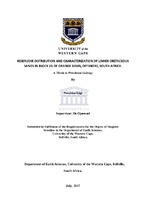| dc.contributor.advisor | Opuwari, Chinyerum | |
| dc.contributor.author | Gigi, Nwabisa | |
| dc.date.accessioned | 2018-08-01T10:59:07Z | |
| dc.date.available | 2018-08-01T10:59:07Z | |
| dc.date.issued | 2017 | |
| dc.identifier.uri | http://hdl.handle.net/11394/6161 | |
| dc.description | Magister Scientiae - MSc (Earth Science) | |
| dc.description.abstract | Orange Basin is a volcanic passive margin that forms part of the southwestern basins that were
formed during the breakup of South America and Africa in Late Jurassic to Early Cretaceous.
The basin comprises of numerous half grabens which are overlain by post rift fluvial deltaic
sediments. This research study focuses on the distribution and characterization of the Albian
deltaic sands across the Ibhubesi gas field. Geophysical and geological data such as 3D seismic
data, wireline logs and core data from four wells (A-G 1, A-K 1, A-V1 and A-K 2) which tested
the Albian reservoirs were integrated for a proper evaluation of the reservoirs.
From Seismic interpretation and well correlation it is apparent that the Albian sands in the
Ibhubesi gas field were deposited in a fluvial-deltaic environment. Seismic attributes have shown
that the wells covered by the 3D seismic data were drilled on sweet spots of the channel axis of
a deltaic system. These channels seem to be diverted by incised valleys across the entire field.
Better sands are expected to develop down dip of the current field as splays in a pro-delta setting.
Results obtained from petrography and petrophysical evaluations have revealed that quartzovergrowths
are the dominant cement across all the Albian reservoirs of the four wells. Quartz
precipitation most likely resulted from the circulation of waters during sediment compaction.
Although these Albian sands are highly cemented with silica, porosities in most reservoir
intervals range between 18% and 23%. These fairly good porosity values are mostly primary
porosities protected from quartz-overgrowth by chlorite rims. The formation of chlorite from
volcanic fragments pre-dates the development of quartz-overgrowth; hence the preservation of
primary porosities. Secondary porosity is also present in some of the reservoir intervals resulting
from leaching of unstable minerals. Permeabilities are generally low due to chlorite rims, quartz
overgrowth and other authigenic clays such as kaolinite and illite which blocked pore
connectivity. Resistivity logs had generally low readings over most hydrocarbon bearing zones
due to the presence of chlorite in the sands. | |
| dc.language.iso | en | |
| dc.publisher | University of the Western Cape | |
| dc.title | Reservoir distribution and characterization of lower cretaceous sands in block 2A of Orange Basin, offshore, South Africa. | |
| dc.rights.holder | University of the Western Cape | |

